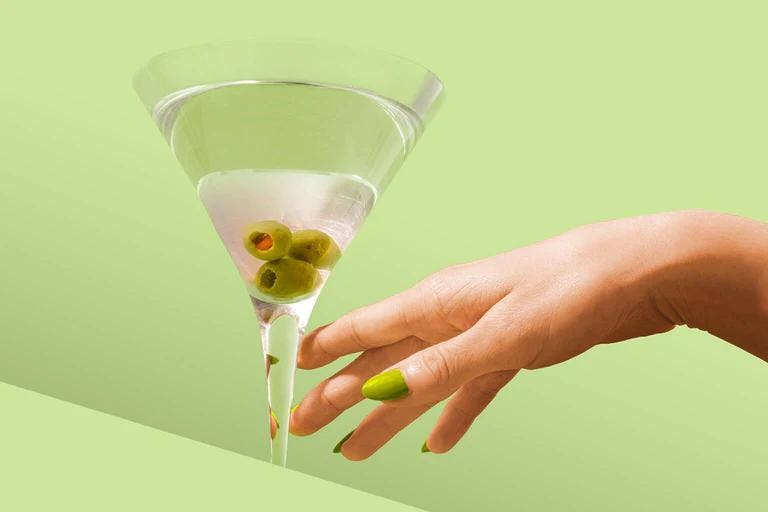How To Make the Perfect Saketini
Table of Contents
The saketini is a familiar yet nuanced modern cocktail. It’s a great beverage for sake drinkers as well as cocktail lovers. Utilizing sake rather than vodka or gin, this cocktail’s recognizable appearance will surprise drinkers with its versatility and wide array of possibilities. But before addressing the saketini, we should clarify that sake is a fermented alcoholic beverage — not a liquor — made from rice. Sake is more similar to beer or wine than distilled spirits, in terms of alcohol content as well as its production method. This difference is important to understand when considering saketinis.
Because of this, constructing a cocktail with sake has its own unique methodology. In this article, you will learn a brief history of the saketini, its relationship and differences to the classic martini, and how to select ingredients and build your own saketini. We’ll also share five recipes for saketinis that you can make at home!
What’s in a saketini? Origins and ingredients
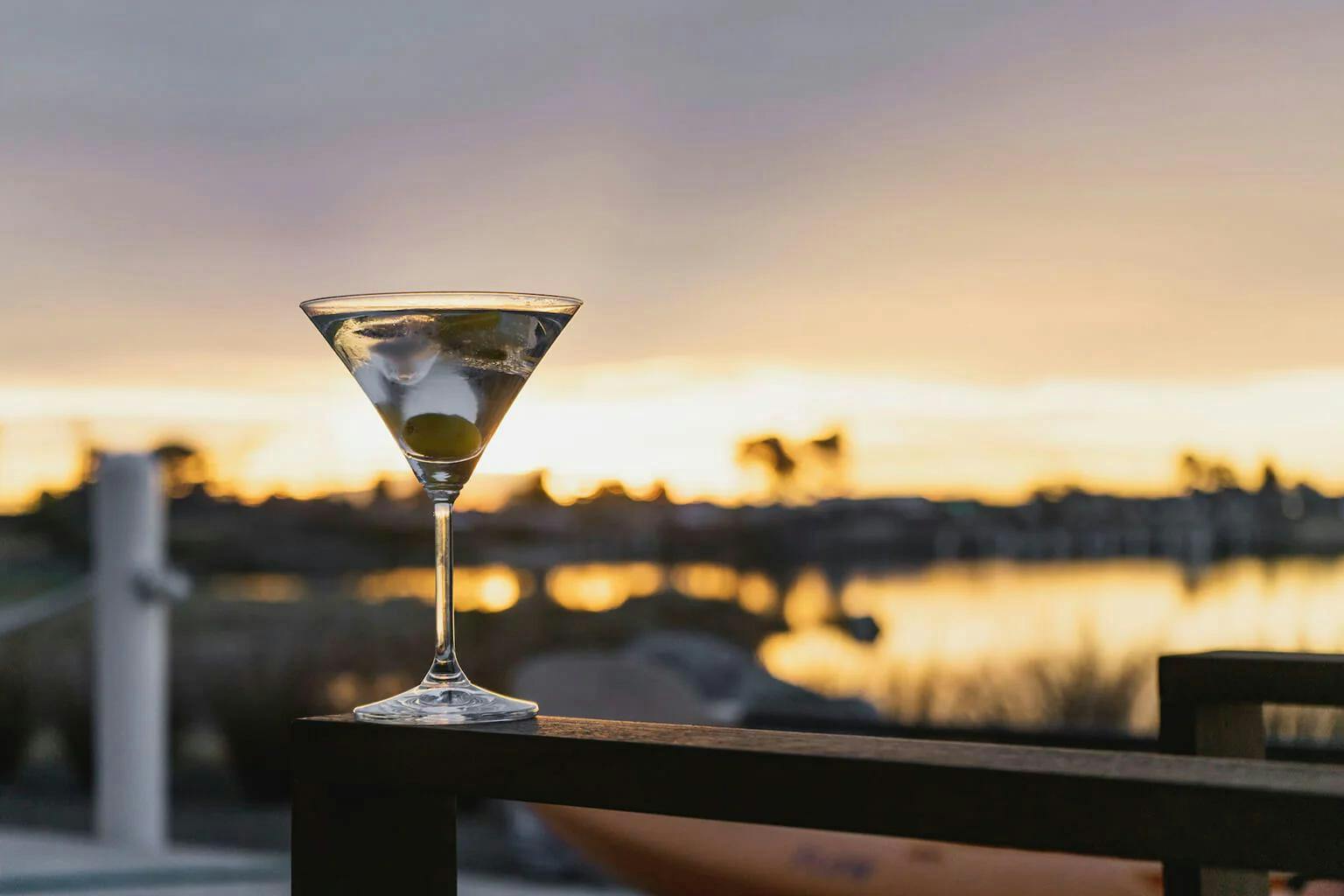
A classic martini with green cocktail olives.
The saketini is a beverage inspired by the martini, a classic cocktail that has existed for over a century in the United States. Made with either vodka or gin, it is either shaken or stirred with ice, sweet or dry vermouth, and sometimes bitters. Traditional garnishes such as a citrus twist, cocktail onion or olive may be used.
It’s believed that a chef named Matsuda-san invented the saketini in Queens, New York, in 1964. Since then — particularly in the 1990s — the saketini has made appearances in many bars and Japanese restaurants. This modern cocktail now exists under a wide umbrella of preparation methods, flavors and variations. The recipes and methodology featured in this article will be akin to the classic martini in that they will use stirring as a means of preparation and chilling the beverage, use dry vermouth or a flavoring agent such as liqueurs, and retain some gin or vodka in the flavor of the final product. Together, we will explore the delicious potential of sake in the form of a martini.
How to choose sake: The best sake for saketinis
Sake comes in various styles and categories, giving you plenty of options for experimentation and a wide gamut of flavors from which to choose. Some sake will make better candidates than others for a martini-inspired cocktail. The spectrum of popular flavor notes in traditional martinis can include but are not limited to: briny, savory, zesty, citrus forward or floral. Luckily, there is an abundance of sake that matches these flavor profiles! When selecting a sake, first identify what flavor outcome you desire for your saketini. Below are three popular examples of sake categories to demonstrate how sake selection can affect the final outcome.
Junmai: rich, savory, versatile
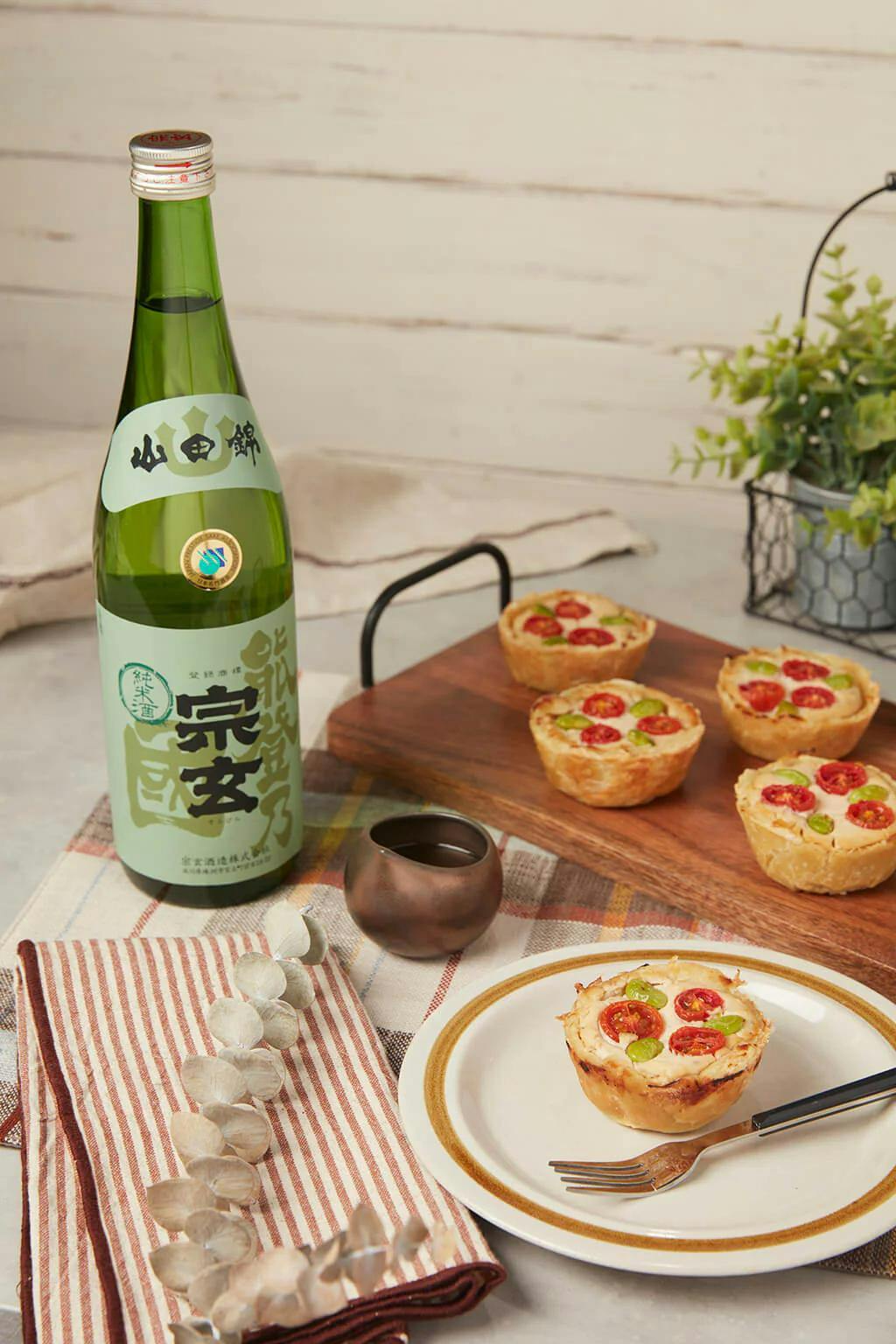
Umami-forward junmai Sogen “Noto no Kuni” Yamadanishiki possesses rich notes of rice and melon — a great match for savory tarts!
Junmai is pure rice sake. There are several categories of sake that include the word “junmai,” such as junmai ginjo and junmai daiginjo. When a sake is labeled as simply junmai, it means that the pure rice sake has no set polishing ratio, whereas ginjo and daiginjo are required to be within a certain parameter of rice polishing. Junmai is a very broad sake category and can greatly vary in flavor.
Junmai — especially those with less polishing — are likely to have a rich and savory character. Sake with pronounced umami will work beautifully in a martini garnished with olives, or even prepared “dirty” by adding some olive brine or crushed olives into the mixture. Shochu, vodka and gin all make great companions to a junmai sake. Though, if one were aiming to make an umami-driven saketini, shochu would likely be the best choice. This also creates opportunity for acidic components such as a vermouth, bitters or citrus.
Genshu: bold, higher ABV
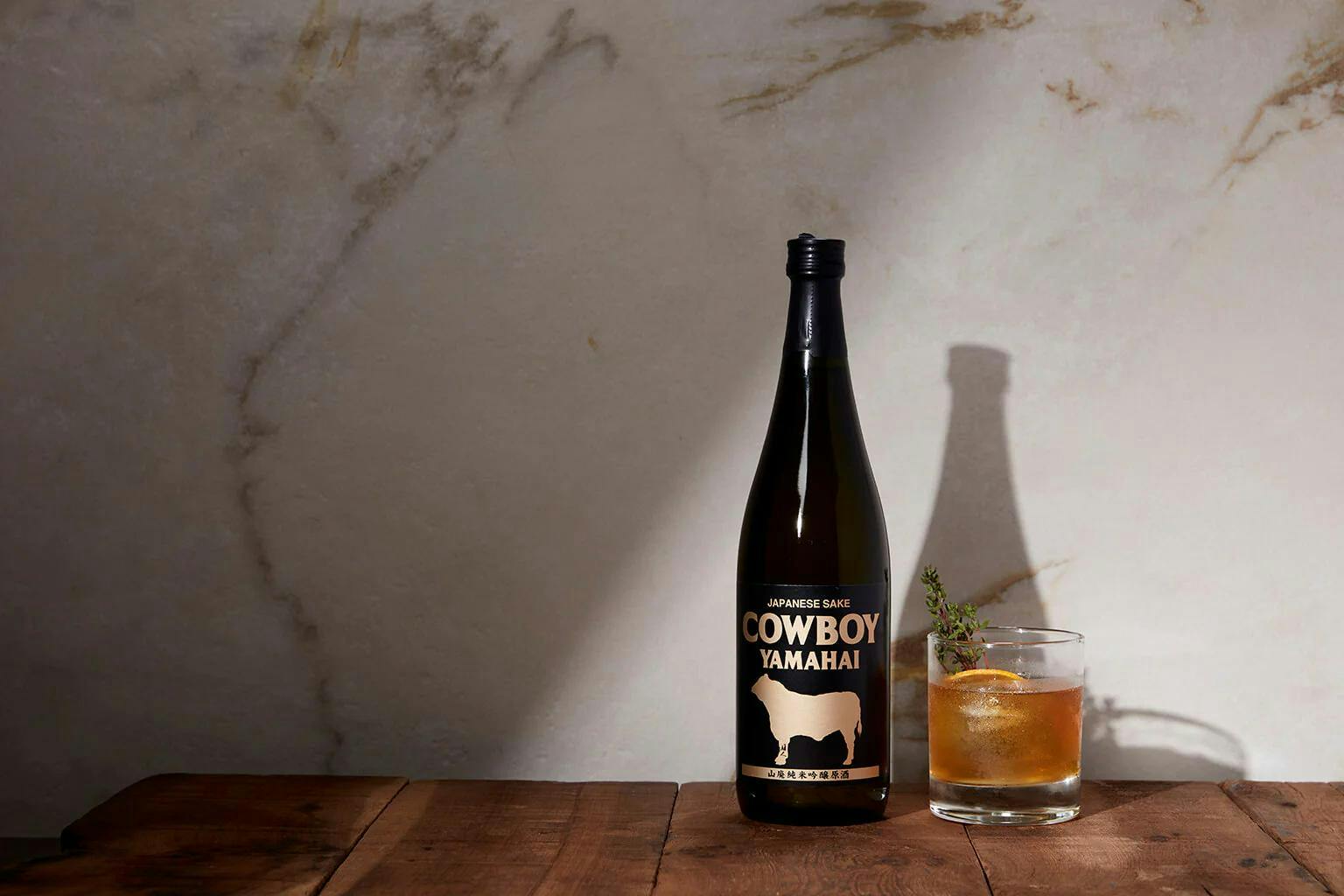
Genshu sake like Cowboy “Yamahai” can be used in cocktail recipes because of its expressive, undiluted flavor.
“Genshu” style sake is fantastic for cocktails because it is undiluted. Unless specified otherwise, most sake are diluted with water in the final stages of production to temper the flavor. Genshu sake delivers big flavor with higher alcohol content. Though other sake does fine in most cocktails when balanced proportionately with other ingredients, genshu does particularly well because of its boldness.
Genshu sake can vary in flavor, due to the category simply indicating that the sake is undiluted. Choosing a complimentary liquor, if any, will depend on the flavor profile of the base sake. A genshu-based saketini could taste delicious and have enough impact on its own without the addition of gin, vodka or shochu! Adding dry vermouth or additional flavor components are always a fun option for those seeking a nuanced flavor. It is not uncommon to drink genshu on the rocks, so chilling it with ice before serving and presenting it as a dry saketini is a great option for purists.
Nama: refreshing, zippy
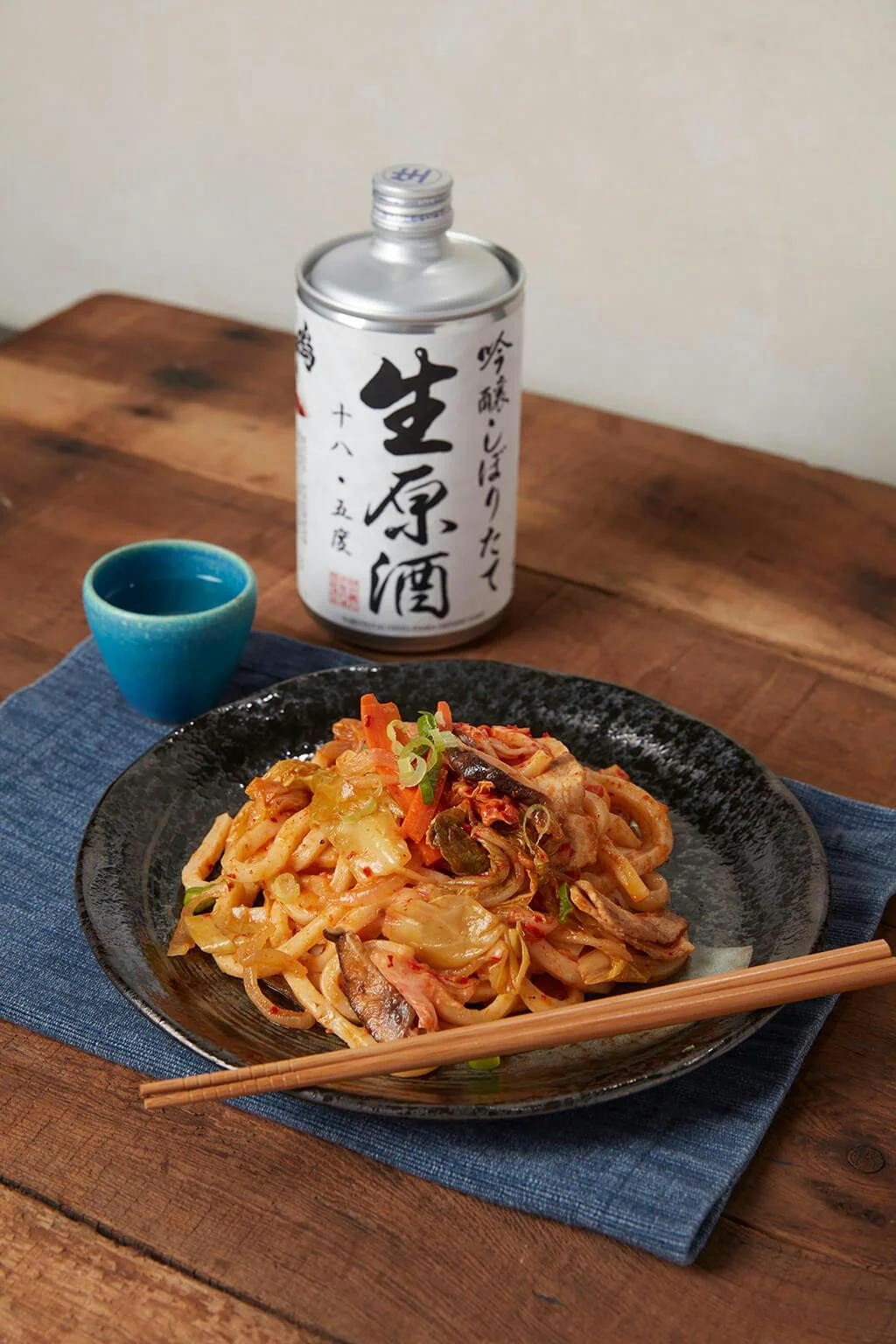
The famous Narutotai “Ginjo” Nama Genshu stands up well to heartier meals, like this spicy noodle dish.
“Nama” is unpasteurized sake. Sake can vary in its pasteurization process; it typically goes through two rounds of pasteurization, although sometimes one or both rounds are skipped. “Namanama” sake skips pasteurization altogether; “namachozo” is only pasteurized prior to bottling; “namazume” is only pasteurized after pressing.
Nama sake are similar to genshu sake in that they are often bolder in flavor. Without pasteurization, these sake are less stable and have higher acidity. Nama and genshu saketinis may not always have the same impact as liquor-based martinis, but they are likely to come close if not be on par. Flavor components and choosing whether the cocktail is served “dry,” “wet” (with extra vermouth), or “dirty” will all be case-by-case judgements depending on the character of the base sake. If the chosen nama sake has a highly acidic profile, adding a savory olive garnish or shochu to your mixture may be a great idea.
What to make it with: vodka, gin or
Adding liquor such as vodka, gin, or even shochu to a saketini recipe can enhance the flavor of the cocktail and raise the alcohol by volume. Doing this keeps the saketini familiar yet nuanced, especially since most traditional martini recipes use vodka or gin as the base ingredient. Choosing which liquor will be most appropriate will depend on the character of the base sake.
Since gin has a pronounced botanical and herbaceous nose, it will compliment sake that have floral notes as well. Vodka is often a neutral-tasting spirit, so it will be better suited for sake that could use the additional alcohol content without disturbing the flavor of the base sake.
Shochu’s alcohol content can vary anywhere from 20%-40%, depending on the brand or type of shochu. Shochu and sake share a common key ingredient, koji, which makes shochu an excellent candidate for a supporting saketini ingredient. Shochu can be very diverse, as it can be made from various grains and/or starches. It may not be the case 100% of the time, but shochu will likely be the best match for savory saketinis as it is an umami-driven spirit.
Though these basic guidelines should help you with most situations, there are always exceptions. Each sake or cocktail may have its own specific needs. Experimentation is important and so is taste testing! Try your sake with various liquors and spirits to ensure you’ve found the best match.
How to make the perfect saketini: recipe and ingredients
The key to making a perfect saketini is balancing the ingredients to ensure they are all represented and contributing to the flavor of the cocktail. The prominent flavor in a saketini should be the sake. Using a higher ratio and measurement of sake in juxtaposition to other ingredients protects the sake’s flavor from getting washed out. The recipes in this article are constructed around a 3.5-ounce build with room for dilution from ice, and minuscule measurements of vermouth, juice or liqueur.
The general ratio of 3 ounces sake to 0.5 ounces liquor is a good starting point for most saketinis. If the flavors do not seem balanced, it is a simple matter of adjusting the measurements. Adjusting in 0.5 ounce increments is suggested for those who need it.
Dry vermouth is a classic component to martinis. (Sweet vermouth can also be used for a wetter cocktail.) Whether this is used in creating one’s own saketini recipe is totally up to their preference. If vermouth is desired in your recipe, it is suggested to only use a small amount for a “rinse,” which coats the surface of the martini glass before discarding the excess rinsing ingredient. Rinsing a martini glass is not limited to using vermouth, as you will see in the below recipes. Using more vermouth than necessary could be undesirable as it may compete with the sake for dominance over flavor representation.
The basic saketini
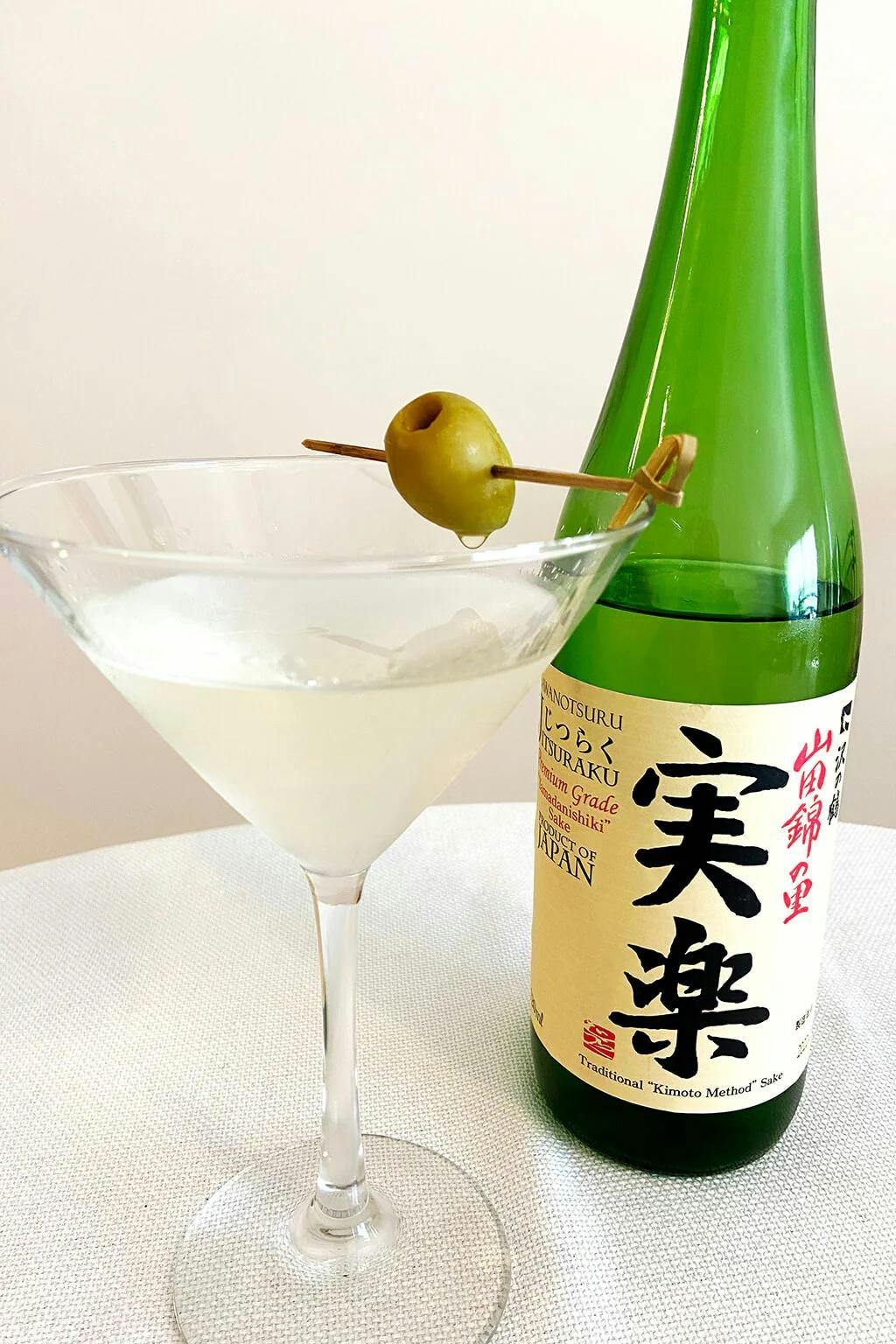
The basic saketini | Photo by Jake Lee
This basic saketini will resemble a classic gin martini, not only in its flavor but also in its preparation. Enough gin is added for flavor representation, but not enough to wash out the base sake. Sawanotsuru “Jitsuraku” is a junmai kimoto sake. Junmai sake make fantastic umami saketinis. This is driven home further by the kimoto production method, a centuries-old way of producing rich, savory, funky sake. Though it is not listed in this example, the already-present briny flavors of this cocktail can be enhanced by making this saketini “dirty.” To make it dirty, add a small amount of cocktail olive brine to your mixture. Regardless, the basic saketini will fulfill your classic martini needs in a surprisingly new direction!
Ingredients:
- 3 ounces sake
- 0.5 ounce gin
- Splash of dry vermouth
- Olive for garnish
Instructions:
Set aside a martini glass and chill it with ice. In a separate pint glass, add 3 ounces sake and 0.5 ounce gin. Add ice to your pint glass. Stir with a bar spoon in consistent circular motions for 30 seconds. Try to keep the bottom side of the spoon flush against the inside of the pint glass without shuffling the ice beyond the necessary circular motions; this helps minimize dilution. After you’ve finished stirring, dump out the ice from your martini glass. Add a small splash of dry vermouth to the martini glass. Lightly move the vermouth around the glass by holding the stem and tilting it at an angle ensuring you cover as much of the inner surface area as you can. Dump out the excess vermouth that remains. Top your pint glass with a cocktail strainer and strain into the vermouth-rinsed martini glass. Skewer one olive and garnish your saketini before enjoying!
Cucumber saketini
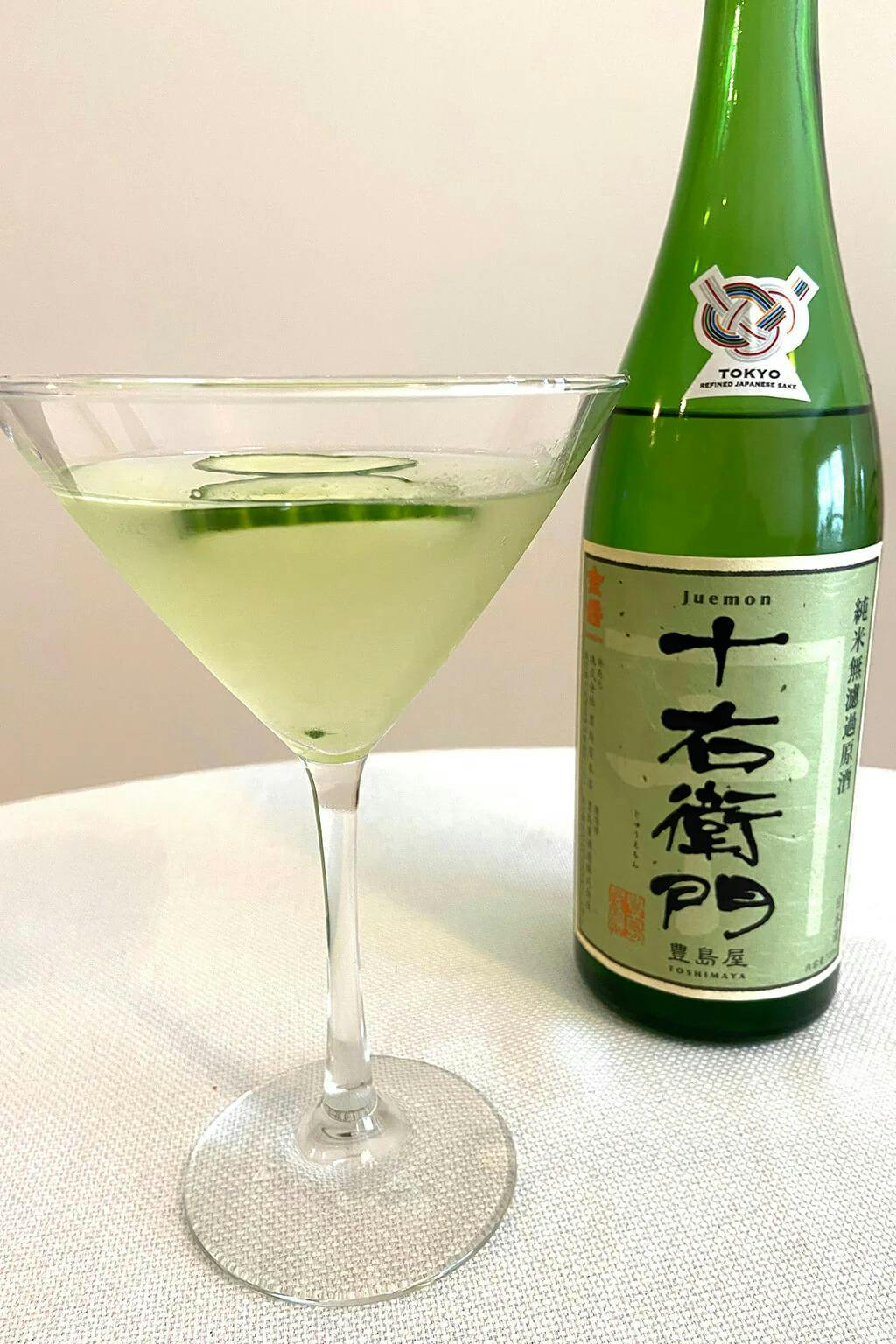
Juemon “Junmai” | Photo by Jake Lee
Featuring Juemon “Junmai” sake, the cucumber saketini balances the boldness of this genshu sake with freshly muddled cucumber. The bright flavors of cucumber and ripe fruit in the base sake are followed by a lovely, savory finish. Shochu amplifies the umami aspect of this saketini, while fresh cucumber preserves the vegetal and fruit flavors. Perfect for a hot summer day or whenever you want to daydream of warmer weather, this sake cocktail will bring you refreshingly delicious flavor.
Ingredients:
- 1-inch cut of cucumber
- 3 ounces sake
- 0.5 ounce shochu
- 2 thin slices cucumber
- (0.5 ounce vodka may be substituted for shochu)
Instructions:
Set aside a martini glass and chill it with ice. Take your 1-inch cut of cucumber and dice it into large pieces before setting in a pint glass. Muddle the cucumber until juice is visible, then add 3 ounces sake and 0.5 ounce shochu before topping with ice. Stir with a bar spoon in consistent circular motions for 30 seconds. After you’ve finished stirring, dump out the ice from your martini glass. Top your pint glass with a cocktail strainer and strain into the chilled martini glass. Gently add your thin slices of cucumber on top so they stay afloat. Enjoy your refreshing cucumber saketini!
Lychee saketini
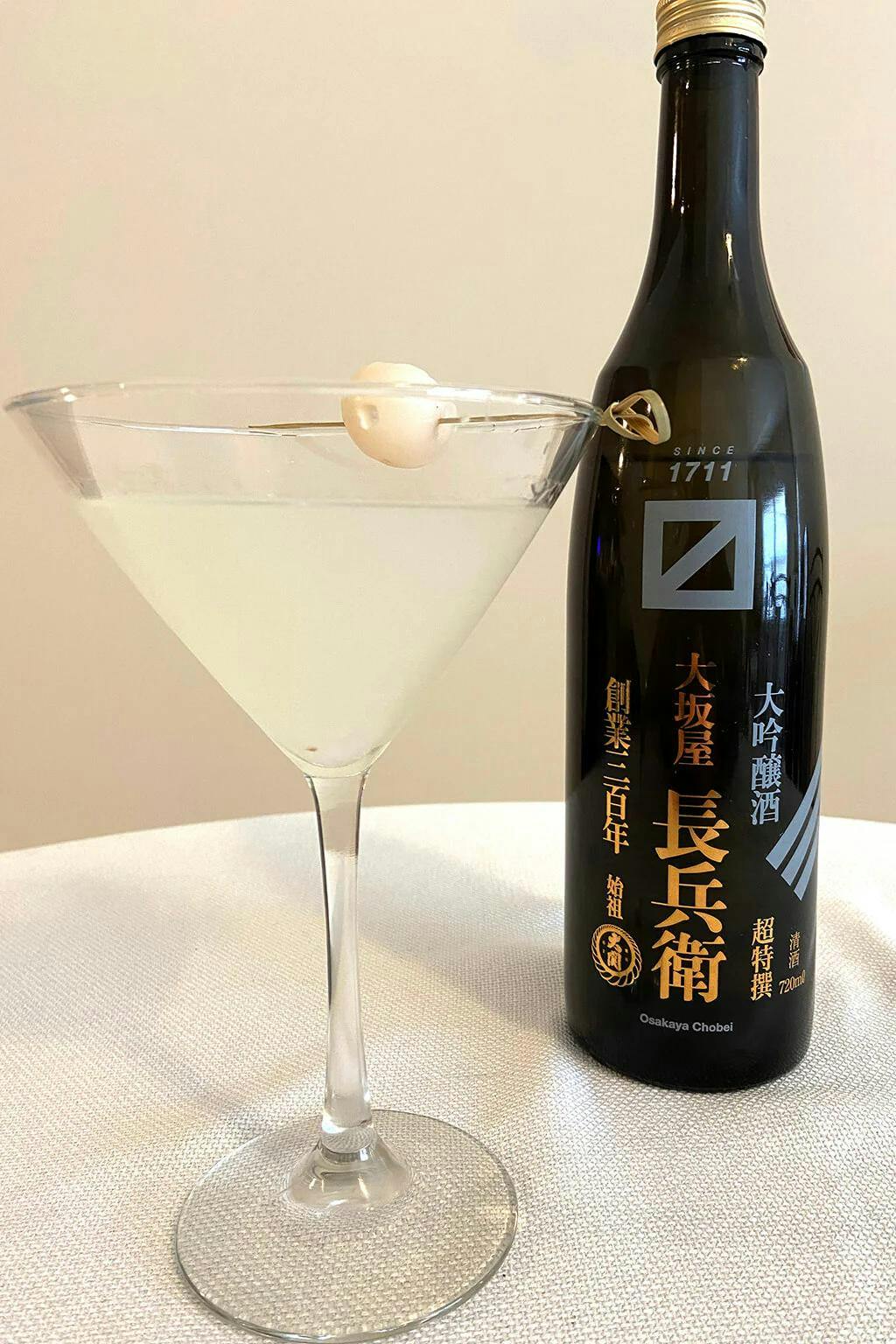
Ozeki “Osakaya Chobei" | Photo by Jake Lee
The lychee saketini is a great option for those wanting something fruity, floral and mellow. Featuring Ozeki “Osakaya Chobei,” this daiginjo’s nose of lychee makes it an excellent choice for a saketini. St-Germain has subtle notes of lychee fruit, as well as a viscosity that builds body for the cocktail. Vodka is used to increase the alcohol content and counter the added sweetness from the canned lychee and elderflower liqueur. Muddling the canned lychee also provides this cocktail with lychee’s recognizable white color. The end result is a balanced sake cocktail that is built upon harmony and synergy.
Ingredients:
- 3 lychee from can with original syrup
- 2.5 ounces sake
- 0.5 ounce vodka
- 0.5 ounce St-Germain
- 1 lychee berry for garnish
Instructions:
Set aside a martini glass and chill it with ice. Take 3 lychees out of a can of lychees in syrup using a bar spoon and add them to an empty pint glass. (It is OK if the spoon also collects some syrup, as that will become part of the mixture.) Muddle the 3 lychees until they become flattened or broken up. Add 2.5 ounces sake, 0.5 ounce vodka and 0.5 ounce St-Germain into the pint glass. Add ice to your pint glass and stir for 30 seconds. After you’ve finished stirring, dump out the ice from your martini glass. Top your pint glass with a cocktail strainer and strain into the chilled martini glass. Skewer 1 lychee berry and garnish your lychee saketini before serving!
Pear saketini
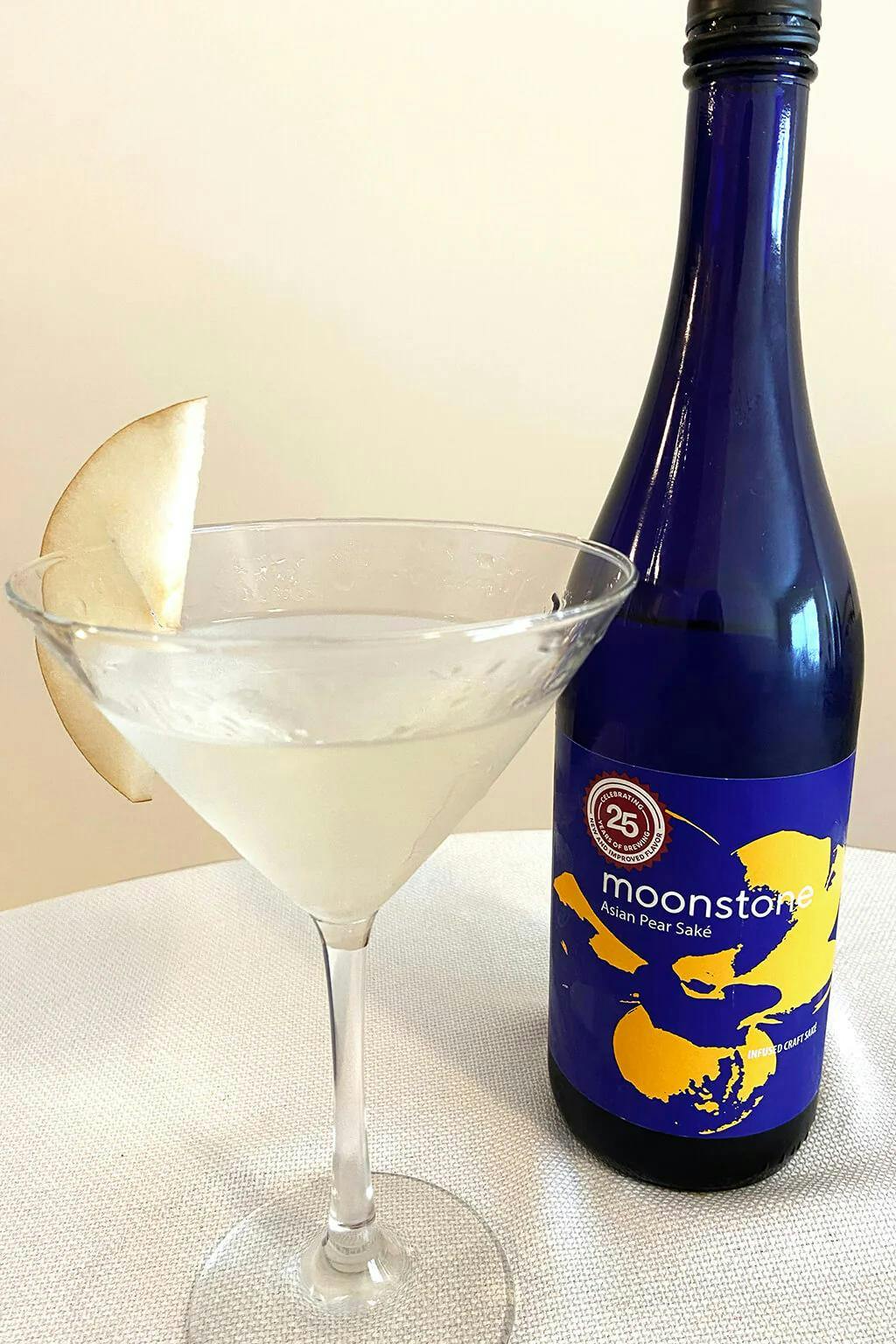
Moonstone “Asian Pear” | Photo by Jake Lee
Moonstone “Asian Pear” sake makes a fantastic pear saketini. The sake itself carries the flavor of pear so well that additional pear components are unnecessary, other than for garnish. St-Germain has notes of pear as well as floral flavors, which provide both complementary and subtly contrasting flavors. Vodka is added to give this saketini extra strength without disturbing the beautiful base sake’s taste.
Ingredients:
- 3 ounces sake
- 0.5 ounce vodka
- Splash of St-Germain
- 1 thin slice Asian pear for garnish
Instructions:
Set aside a martini glass and chill it with ice. In a separate pint glass, add 3 ounces sake and 0.5 ounce vodka before topping with ice. Stir with a bar spoon in consistent circular motions for 30 seconds. After you’ve finished stirring, dump out the ice from your martini glass. Rinse your emptied martini glass with a small splash of St-Germain, covering as much of the inner surface area as you can by rotating it from the stem. Dump out the excess elderflower liqueur from your glass. Top your pint glass with a cocktail strainer and strain into the chilled martini glass. Either cut a small slit on your fresh asian pear slice and garnish it on the side of the glass, or simply slide the pear slice into your martini mixture. Enjoy the fragrant aromas of pear and elderflower before taking a sip!
Plum wine martini
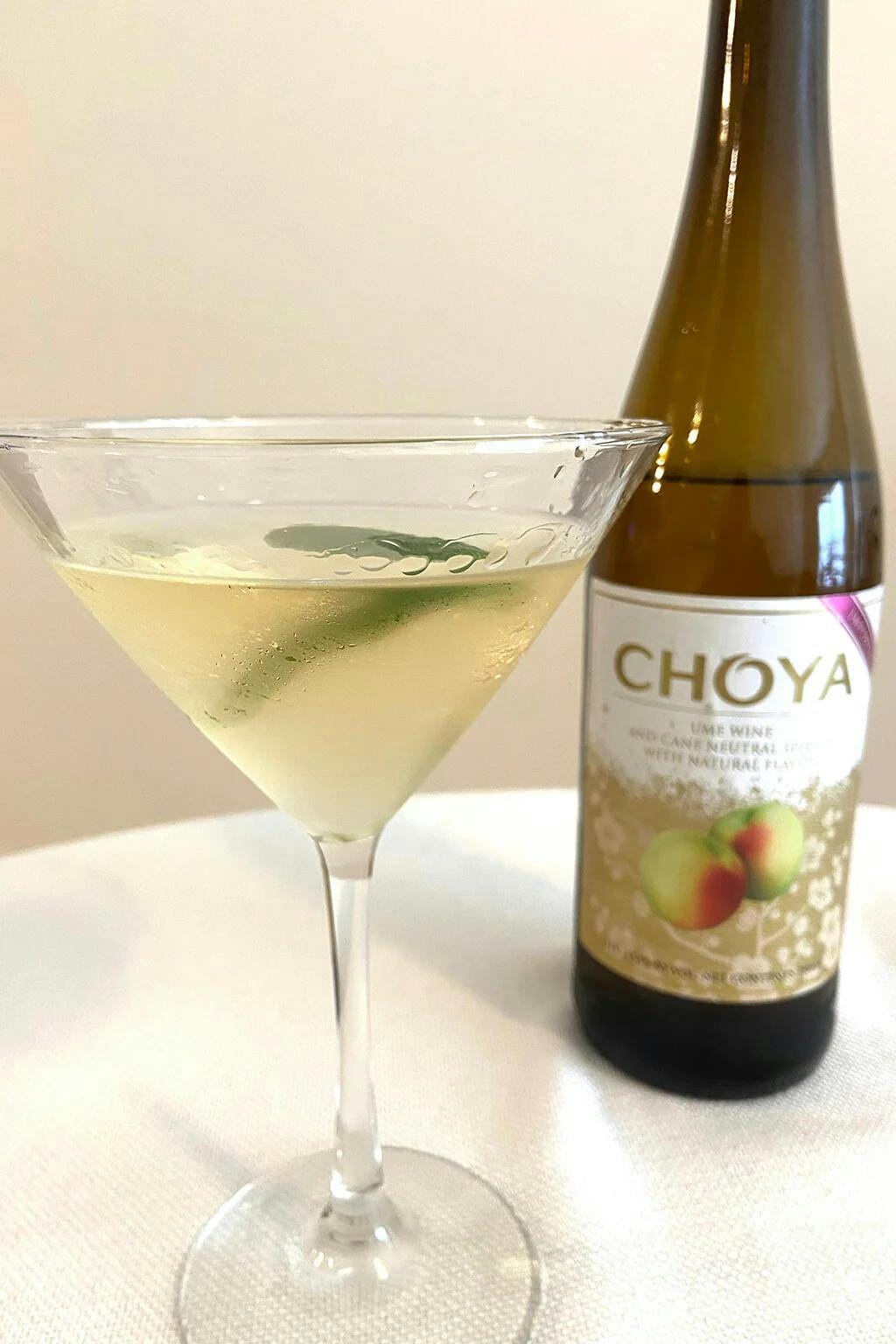
Plum wine martini | Photo by Jake Lee
Though Choya “Plum Wine” is not “seishu” (strictly defined sake), it exists in a similar realm and is often categorized with sake for its familiarity. (Learn more about what plum wine is and how it’s made.) Dry vermouth has a lovely, subtle tartness that balances the plum wine’s rich, jammy flavors. The addition of gin’s floral nose transforms this martini into a bouquet of floral and fruity notes. Building the plum wine martini uses the same methodology of the saketini to create a cocktail that demonstrates both contrast and balance.
Ingredients:
- 2 ounces plum wine
- 1.5 ounces gin
- Splash of dry vermouth
- 1 freshly peeled lime twist
Instructions:
Set aside a martini glass and chill it with ice. In a separate pint glass, add 2 ounces plum wine and 1.5 ounce gin before topping with ice. Stir with a bar spoon in consistent circular motions for 30 seconds. After you’ve finished stirring, dump out the ice from your martini glass. Rinse your emptied martini glass with a small splash of dry vermouth. Dump out the excess. Top your pint glass with a cocktail strainer, then strain into the martini glass. Express the oils from your lime twist on the martini glass and gently rim the glassware with it to utilize all of the aromatic oils. Enjoy your refreshing plum wine martini!
Has your opinion on the saketini been shaken, or stirred?
The saketini is a wonderful way to experiment and play with sake in cocktails. With a small handful of ingredients and only a few steps involved, you’re certain to impress your friends — or even yourself! For further sake cocktail reading check out this mixology guide, which includes 15 sake cocktail recipes. Need help choosing some bottles to play with? We have you covered. Read this article for the best bottles for beginners.
The possibilities available for saketinis are endless. But most importantly, you should enjoy the fun process as well as the delicious fruits of your labor. Enjoy your sake and enjoy your cocktails! Kampai!
Resources:
“Saketini.” Taste Atlas.
https://www.tasteatlas.com/saketini
Kendrick, J. “The Evolution of Sake Cocktails & 3 Tips for Making Great Ones.” The Alcohol Professor, 2022.
https://www.alcoholprofessor.com/blog-posts/sake-cocktails

Jake Lee
Residing in Seattle, WA, Jake is a Japanese food and beverage professional who has worked at some of the city’s finest Japanese restaurants. His education continues with a focus on sake and its history. Outside of work, Jake enjoys pursuing art and studying history.
Learn about Tippsy’s Editorial process
Recent posts
All about sake
Sign up to receive special offers and sake inspiration!
